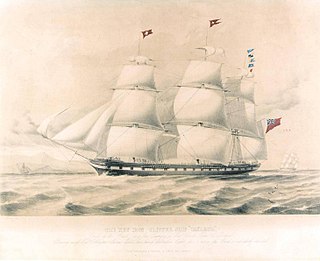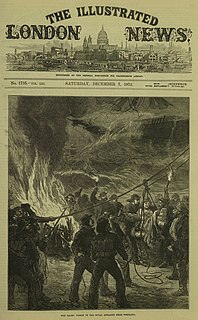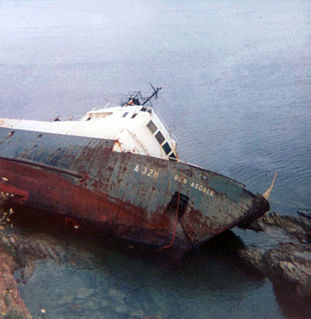The Jessie Logan was an American-built English East Indiaman which was wrecked after striking rocks near Boscastle on the north coast of Cornwall, South West England in January 1843. The subsequent unlawful raiding of the ship's cargo by locals led to a change in the law.
Jessie Logan was a cargo ship built in North America in 1830. It was known as a “Quebecker” and was owned by J Logan & Co of Liverpool. The ship weighed 805 tons.
Jessie Logan left Calcutta on 14 September 1842 bound for Liverpool with a cargo of rice, cotton, flax, spices, buffalo horns and hides, shellac, raw sugar and dyewood. On 22 January 1843, the ship was driven onto rocks near Blackapit, just south of Willapark, Boscastle. The storm which affected Northern France and South West England caused the loss of 180 ships and the deaths of 450 people. [1]
Heavy seas on the 13th January had carried away the ship's poop, crushed its stern, and swept the decks. The ship was aiming for the safety of Bude or Tintagel Haven when the ferocity of the storm raised to gale force. Distress signals were fired but with the vessel completely unmanageable, the crew abandoned ship on 15 January and were picked up by another ship, the Lynx. At the time, there was 13 ft of water in the hold. Now at the full mercy of wind and waves, the ship drove onto rocks near Blackapit, just south of the Willapark headland on 22 January. [2]
The dyes stained the seas red around the wreck site and parts of the ship and cargo were driven onto the shore. [2] Wrecks were seen as an act of providence in nineteenth century Cornwall and despite the presence of coastguards and the ship's owner, little could be done to prevent locals hauling away the washed up cargo. This opportunistic salvage is known as wrecking even though many wreckers had no involvement in a ship's loss. Two ringleaders, Hugh Luckey and Robert Chapman were both caught and sentenced to a year's hard labour. [3]
Barrister William Palmer proposed to make the hundreds of Boscastle people who plundered the Jessie Logan liable under law. [3] Palmer's greater concern was with those wreckers who lured ships to their doom. However, there is no evidence that anyone looting the Jessie Logan's cargo fought coastguards or endangered life; there was simply too much cargo for the limited number of coastguards to protect. Palmer's suggestions were realised in 1846 when the first major bill for the consolidation of the laws of wreck and salvage was passed.
In August 1975, divers Paul Day and Frank Bridge salvaged the anchor of the Jessie Logan. The anchor had been discovered by local diver Michael Webber. It is now on display in Boscastle and is commemorated with a plaque.
Folk singers Paul and Penny Mack released Wreck of the Jessie Logan in 1995.
Wrecking is the practice of taking valuables from a shipwreck which has foundered or run aground close to shore. Often an unregulated activity of opportunity in coastal communities, wrecking has been subjected to increasing regulation and evolved into what is now known as marine salvage.

A shipwreck is the wreckage of a ship that is located either beached on land or sunken to the bottom of a body of water. Shipwrecking may be intentional or unintentional. Angela Croome reported in January 1999 that there were approximately three million shipwrecks worldwide.

The Northern Belle was an American transatlantic ship which ran aground near Thanet, England, on 5 January 1857. No lives on her were lost, thanks to heroic rescue efforts, in blizzard conditions. However, another ship sank, en route to the scene, the Margate lugger Victory which was lost along with her crew.

RMS Tayleur was a full-rigged iron clipper ship chartered by the White Star Line. She was large, fast and technically advanced. She ran aground off Lambay Island and sank, on her maiden voyage, in 1854. Of more than 650 aboard, only 280 survived. She has been described as "the first Titanic".
The Receiver of Wreck is an official who administers law dealing with maritime wrecks and salvage in some countries having a British administrative heritage. In the United Kingdom, the Receiver of Wreck is also appointed to retain the possession of royal fish on behalf of the British crown.

MSC Napoli was a United Kingdom-flagged container ship that developed a hull breach due to rough seas and slamming in the English Channel on 18 January 2007. She was deliberately run aground at Lyme Bay to avoid an environmental disaster and broken up by salvors.

The SS Mohegan was a steamer which sank off the coast of the Lizard Peninsula, Cornwall, on her second voyage. She hit The Manacles on 14 October 1898 with the loss of 106 out of 197 on board.

The Royal Adelaide was an iron sailing ship of 1400 tons built by William Patterson at Bristol in 1865.

Ben Asdale was a Scottish trawler that was wrecked in December 1978 near Falmouth, Cornwall.

The Gwineas, also known as The Gwinges, are a set of approximately fifteen rocks in the extreme southern English Channel, off the coast of the fishing village of Gorran Haven, Cornwall, United Kingdom, remarkable for its seals, dolphins, gannets, and cormorants. There is not too much known about the Gwineas. Like other notable rocks around the Cornish coast, the Gwineas is always locally referred to as 'Gull Rock'. This may also be reflected in the name, if it has been made up from the Cornish words meaning 'white' and 'island'.
Iota was a wooden barque built in Bideford in 1866 and weighing 572 tons. The ship was owned by an Italian firm named Mazella based in Naples and was wrecked near Tintagel, Cornwall, on 20 December 1893.

50.689°N 4.703°W